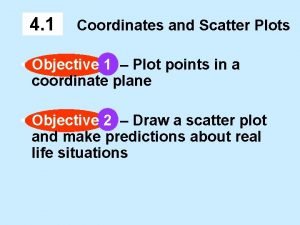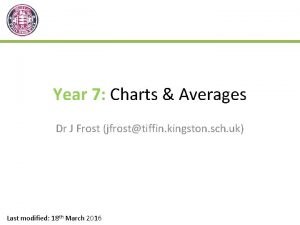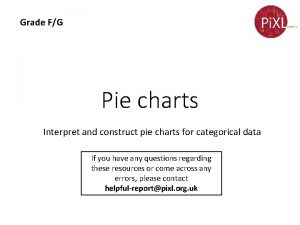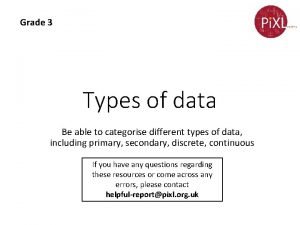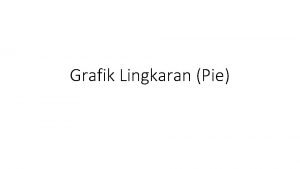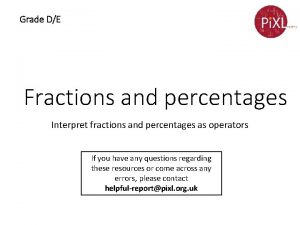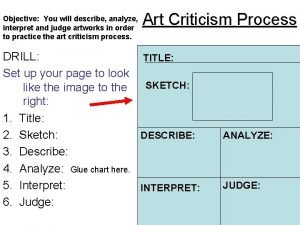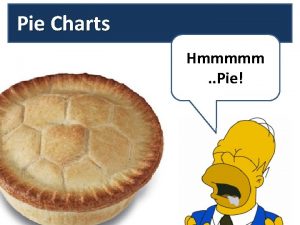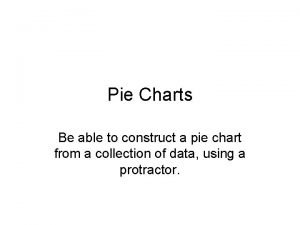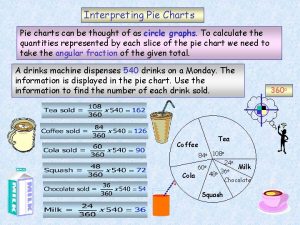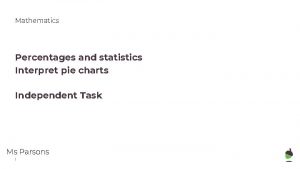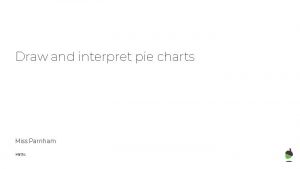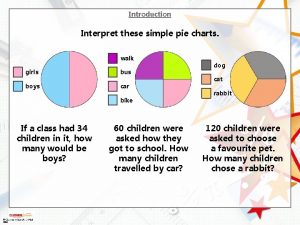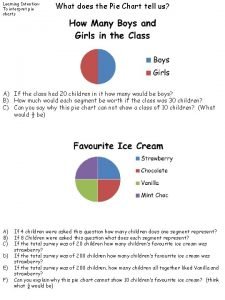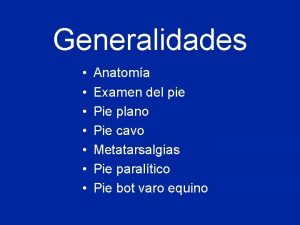Pie charts Interpret and construct pie charts for















- Slides: 15

Pie charts Interpret and construct pie charts for categorical data If you have any questions regarding these resources or come across any errors, please contact helpful-report@pixl. org. uk

Key vocabulary Pie chart Categorical data Qualitative data Discrete data Proportion Fraction

Pie charts – key points • Pie charts are most usefully used when data is categorical (qualitative) or discrete. • Unlike bar charts and vertical line charts, pie charts are used to display the proportions into which a set of data is divided. • We draw and split up a circle into areas into the same ratio as the information we are representing. • Key fact; there are 360° in a full turn. This will be used to represent the complete set of data.

Drawing aa piechart Drawing Jerry counts the colours of of theflowersininhis hisgarden. He collects the results in in thetable. Colour of flower Frequency Red 3 Yellow 8 Pink 4 Blue 5 3 + 8 + 4 + 5 = 20 360° ÷ 20 = 18° Each flower is represented by 18°

Drawing a pie chart Jerry counts the colours of the flowers in his garden. He collects the results in the table. Colour of flower Frequency Angle Red 3 Yellow 8 Pink 4 Blue 5 3 54° × 18 8144° × 18 4 72° × 18 5 90° × 18 Click a colour to see the calculation for its angle. Click the calculation to see the angle. 3 + 8 + 4 + 5 = 20 360° ÷ 20 = 18° Each flower is represented by 18°

Drawing a pie chart Jerry counts the colours of the flowers in his garden. He collects the results in the table. Colour of flower Frequency Angle Blue Pink Red 3 54° Yellow 8 144° Red Yellow Pink 4 72° Blue 5 90° 3 + 8 + 4 + 5 = 20 360° ÷ 20 = 18° Each flower is represented by 18°

Drawing a pie chart 1 Amanda works in a cafe. She records the drinks that people order. Drink Frequency Tea Coffee Water 24 37 19 Juice 10 360° ÷ 90 = 4° 2496° × 4 37 148° × 4 1976° × 4 1040° × 4 Remember; the angles in a circle total 360°. Equate this to the total number of items of data. 2 I note how my dog spends his day. I record my findings in a table. Activity Frequency Walk 2 Eat 1 Play 4 Sleep 13 360° ÷ 24 = 15° 2 30° × 15 1 15° × 15 4 60° × 15 13195° × 15 Other doggy stuff 4 4 60° × 15 3 Bob counts the colours of the cars in a large car park. He collects the results in the table. Colour of car Frequency Black 150 White 80 Silver 330 Red 50 Other 110 × 0. 5 80160° × 0. 5 330 165° × 0. 5 5025° × 0. 5 11055° × 0. 5 360° ÷ 720 = 0. 5° 15075° Click a table, up to three times, to see three steps to calculating the angles needed.

Drawing a pie chart Frequency Often for exam questions the data is given in another form (e. g. bar chart or pictogram) and then you need to convert into a pie chart. Draw with students on interactive whiteboard. Angles are 78, 180, 60, 42.

Interpreting a pie chart (1) 60 people were asked which of four football teams they supported. Their answers are summarised in the pie chart. City United 54° 102° Town 90° 114° Total of angles in a circle is 360° Rovers How many people supported Town? 102° ÷ 6° = 17 How many people supported Rovers? 114° ÷ 6° = 19 Remember; the angles in a circle total 360°. Equate this to the total number of items of data. 360 ÷ 60 = 6° What fraction of these people supported United? 90 = 1 360 4 Remember, pie charts are used to display the proportions into which a set of data is divided. Expect to see questions about fractions…

Interpreting a pie chart (2) A group of students were asked to name their favourite savoury pie. Their answers are summarised in the pie chart. 7 students said “Cheese”. How many people said “Chicken”? 55° ÷ 5° = 11 Steak Pork What fraction of 120° 150° people said “Steak”? 120 = 1 35° 360 3 55° Cheese What fraction of people said Chicken “Pork”? Total of angles in a circle is 360° 150 = 5 360 12 Expect to have to simplify fractions Remember; the angles in a circle total 360°. Equate this to the total number of items of data. If you can’t do this, one of the categories will help instead… 35°÷ 7 = 5° per pie

Interpreting a pie chart practice questions 120 people were asked what their favourite crisp flavours were. The answers are summarised in the pie chart. Plain 42° Cheese & Onion 105° Chicken A farmer has 600 animals. The number of each type is shown in the pie chart. Sheep Goats Poultry 51° Cows Salt & vinegar How many people chose Plain? 14 How many people chose Chicken? 31 What fraction of people chose Cheese & Onion? 1 3 Seniors 58. 5° 33° 210° 120° Of the visitors to the zoo, 20 were children. The different categories of visitors are shown in this pie chart. How many goats does the farmer have? 55 How many sheep does the farmer have? 110 What fraction of the farmer’s animals are cows? 7 12 Children 90° Concessions 103. 5° Adults How many adults visited the zoo? 23 How many visitors were there in total at the zoo? 80 What percentage were concessions? 30%

Interpreting a pie chart Exam style question 360° ÷ 450 = 0. 8° 140° ÷ 0. 8° = 175 …or… 450 ÷ 360° = 1. 25 × 140° = 175

Interpreting a pie chart Exam style question The ×total 70° 2 = 140° number of animals in June could be greater than in February

Specimen Paper Question

Specimen Paper Question
 4-1 construct and interpret scatter plots
4-1 construct and interpret scatter plots Gcse pie chart questions
Gcse pie chart questions Dr frost frequency polygons
Dr frost frequency polygons Constructing pie charts worksheet
Constructing pie charts worksheet Pixi pie charts
Pixi pie charts Pixi pie charts
Pixi pie charts Pie charts in r
Pie charts in r Cara membuat diagram lingkaran di excel
Cara membuat diagram lingkaran di excel Narrative report with contextual description
Narrative report with contextual description Fraction to percentage table
Fraction to percentage table The ability to locate interpret and apply information
The ability to locate interpret and apply information The ability to locate interpret and apply information
The ability to locate interpret and apply information Analyze vs interpret
Analyze vs interpret Describing art work
Describing art work Mean absoulte deviation
Mean absoulte deviation Interpret and analyze
Interpret and analyze
